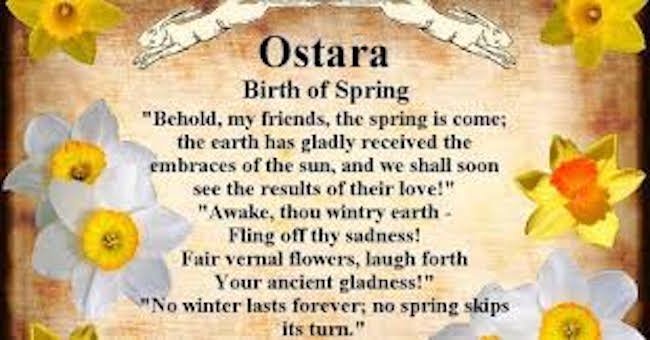Ostara
Sun 4.17.22
Out heading for the bus, I’m going shopping at Hannaford Brothers in Falmouth, my weekly jaunt to the supermarket. I get to the bus station at least ten minutes ahead of its schedule. Twenty minutes later no bus. It happens. I decide on a one-mile walk to catch it on its return trip. I get there, a type of mini mall, and notice Shaw’s supermarket is closed. Why is that? Oh yes, Easter! We’re still an anglo-saxon, Christian country in spite of all the immigrants we’ve acquired. I’ve got about 15 minutes; I run over to CVS to pick up some make-up, actually, it’s concealer to hide the flaws. Two minutes left, I make a dash to the bus stop. Ten minutes later, I realize the bus also takes a break at Easter.
Well, I should too. In my building, people like to decorate their front doors, minimal holiday fare, but some go all out. The theme on my door presently is a celebration of spring, Viking-style. There is a picture of the ancient Goddess Ostara celebrated in holiday by the Vikings at the spring equinox, the turning of the wheel, as the witches say. There is the 19th century addition to the Ostara myth in which, as the bringer of spring she is late one year. Ostara had stumbled upon a dying bird and decided to do something. She changed the little bird into a hare just before death. Oh, and she decided to add a little quirk. She granted it the ability to lay eggs once a year. The bird/hare was so overcome with appreciation for this gift that he laid colored eggs for her, and does so every year. Well, the 19th century version is a little “cute.” Not something the mighty Norsemen and women would hold any interest in. Their spirit world was more earthly.
Hare, the immoderately prolific seducer, creates new life, and Ostara’s gift is also a symbol of spring’s ability with its warm sun, to nurture the life within, which at some point breaks the shell that has nurtured and now imprisons, producing a new beginning for the chick. Jesus rising from the dead after being tortured and nailed to a cross is a bit extreme as symbol for the renewal of life. But then Christianity and most modern religions are not trying to connect us, in a meaningful way, to the experience of life. Mostly, they see their task, they are a product of the city states that fostered them, as adapting us to our reduced circumstances as subjects of the city-state, the government. It’s a necessary restriction and melding of self to accommodate the larger whole, the city state.



